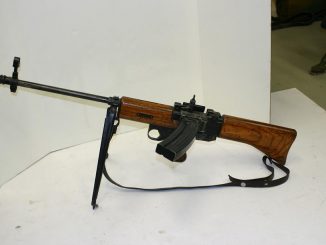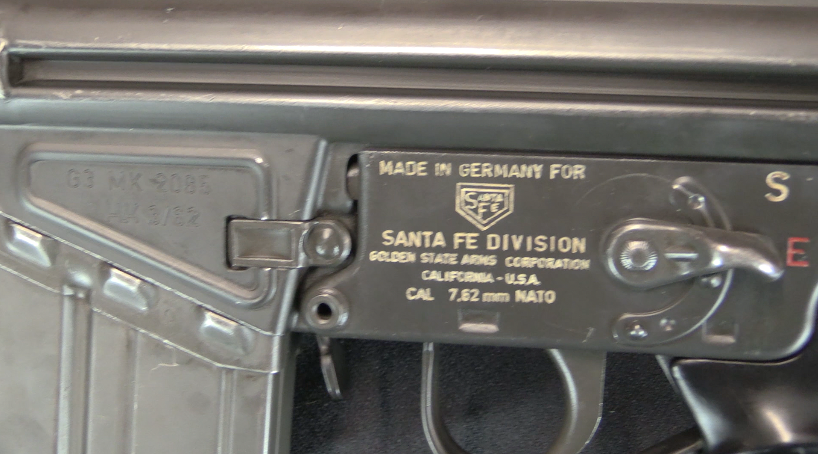We have previously looked at the original MP-18, the System Schmeisser improvement, and the followup MP-28,II design on the table – but we have not taken the MP-28 out to the range. So, that’s what we are doing today – how does it compare to its Schmeisser-magazine predecessor?
© 2025 Forgotten Weapons.
Site developed by Cardinal Acres Web Development.




C’mon, Ian. We know you can pump rounds down range. The question is whether you can hit anything. Show us the targets
It’s not a precision rifle. Who cares what the groupings are like?
“It’s not a precision rifle.”
Then my does it have semi-automatic mode?
“Who cares what the groupings are like?”
Because, believe it or not, the object of the exercise is to hit the target
Meh, Ian’s given us some “dancing bowling pins” views of some of his SMG test-firings. I think tinkering with cameras to capture the firer and the firearm in a single “frame” for video purposes is more complicated than any of us can quite fathom… I’ve made similar critiques of other firearm videos, and then contemplated those issues. But, of course, if shooting at steel, then one can make out the “pinging” noises… Shooting at paper, one could produce a final “group” or “beaten zone” for the grand finale. The bowling pins can be a nice touch too.
Ian strives to show us operations now and again, and then regales us with his 2-gun matches or pistol-caliber course of fire videos….
“(…)“It’s not a precision rifle.”
Then my does it have semi-automatic mode?(…)”
Keep in mind that STEN Mk. III also have such feature. Would you count it as “precision rifle”?
Anyway, I guess answer to your question is simple: because customers wished so.
Ian, the Sten magazine was a copy of the MP28 stick, and had NOTHING to do with MP38/40, which was the next stop in development of the Schmeisser magazine after the MP18 n/A stick (NOT interchangeable with MP28) and MP28. The MP28 was meant as an export gun, and it was being made in various calibers, and thus the magazine was wide-bodied (wide in direction back-to-fore, not thick), to contain anything from 9 mm x 19 Luger to 7,63 mm x 25 Mauser. The redundant space at the back of the body was filled with a rib guiding the follower, and the rib was exchangeable, for various round lengths (and thus the follower widths), making the magazine body multi-caliber of sorts. Making the filling rib costed money, and thus for military contracts in 9 mm Luger, an integral (or fixed) filling rib was used instead, being but a channel bent into the rear wall, along which the follower was guided. That cheaper military magazine was copied by the British, first for the Lanchester, then for the Sten – thus it was interchangeable (for the most part, that is) with the German gun. Later on, MP28-style mags were also used for the German Sten, the MP3008 or Geraet Neumuenster, closing the copy-and-paste circle.
The MP38/40 was designed with just 9 mm Luger in mind from the start, thus the multi-caliber feature proved redundant, and has been discarded by making the body narrower (back-to-front), to accept only the relatively short (in comparison with 7,63 Mauser, 9 mm Mauser or .45 ACP) 9 mm x 19 Luger ammunition.
Oh, sorry – you have already covered the multi-caliber feature in the MP18 Police Improvement video.
to lazy to look it up in his Lanchester video, but isn’t the magazine lineage: mp 18, mp 28, Lanchester, stengun?
High-quality SMGs seem like overkill, or rather extravagant-kill, until you consider peacetime service. A military/police weapon that can last 30 or 40 years and provide training for hundreds of men is worth machining time and, in this case, handsome wood furniture.
Question: Did anybody do a proper man’l of arms with MP18s? Because I bet you could.
“High-quality SMGs seem like overkill, or rather extravagant-kill, until you consider peacetime service. A military/police weapon that can last 30 or 40 years and provide training for hundreds of men is worth machining time and, in this case, handsome wood furniture.”
Really? I call BS. AS an ex-Armor officer, I can state we had plenty of M3A1’s in Armor units in the early Nineties that had been stamped out for a dozen bucks in 1944-45 that had lasted for fifty years and provided training for hundreds of tank crewmen. The only reason the Army got rid of them was that it went from a 45 caliber to 9 mm pistol and the advantage of common ammunition between the pistol and submachine gun was lost.
“(…)plenty of M3A1(…)had lasted for fifty years(…)”
Note that WW2 production was generally excessive when regarding against immediate post-war era. This means that weapons you mentioned were used so long as there were because there was readily available stockpile, allowing easy replacing of worn-out example. Question is how long was average lifetime for examples of M3A1 as opposed to “High-quality SMGs seem like overkill”
Too bad no-one landed a contract to convert the legacy M3A1s to 9mm, so they’d still be chugging along, eh? Of course, that’s not really how contracting works, particularly these days I’d guess…
It’s hard to say what the real reason is.
The first version is that these devices were in active service until they were completely used up. Therefore, they almost never made it to the civilian market.
Second, the trigger is designed in such a way that conversion into SAO is too expensive, and the output still leaves an ersatz-quality tin.
It’s easier to make something new.
I think both are relevant 50/50.
https://www.smallarmsreview.com/images/articles/art_002587/001.jpg
https://www.smallarmsreview.com/display.article.cfm?idarticles=2990
https://www.proxibid.com/Firearms/Pistols/GM-Guide-Lamp-Division-M3-Grease-Gun-with-9mm-Conversion-Kit-Extra-Magazines/lotinformation/64393887